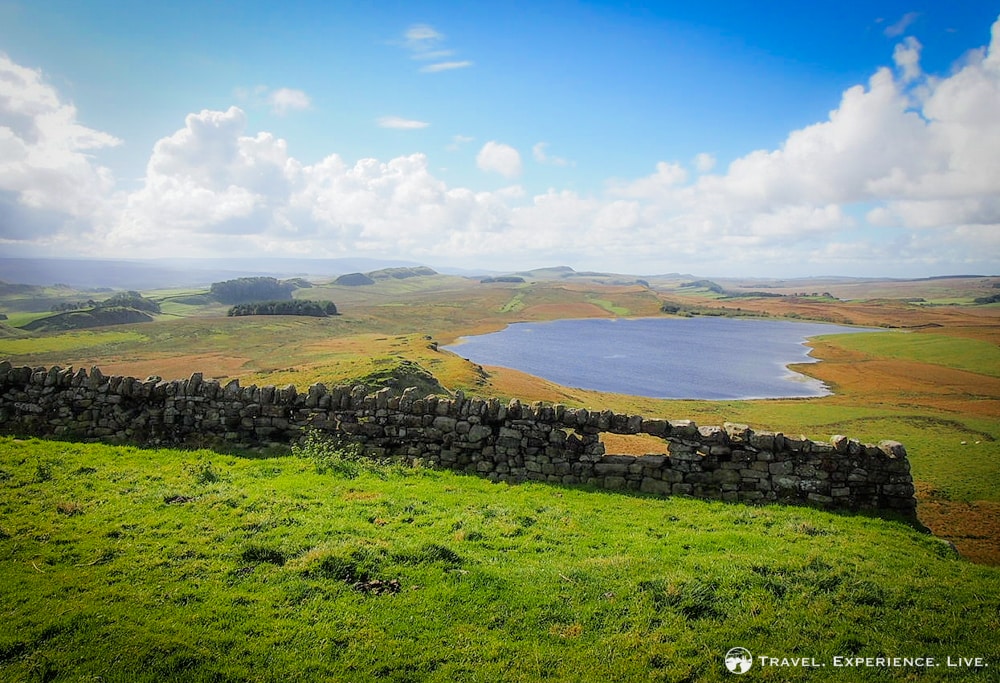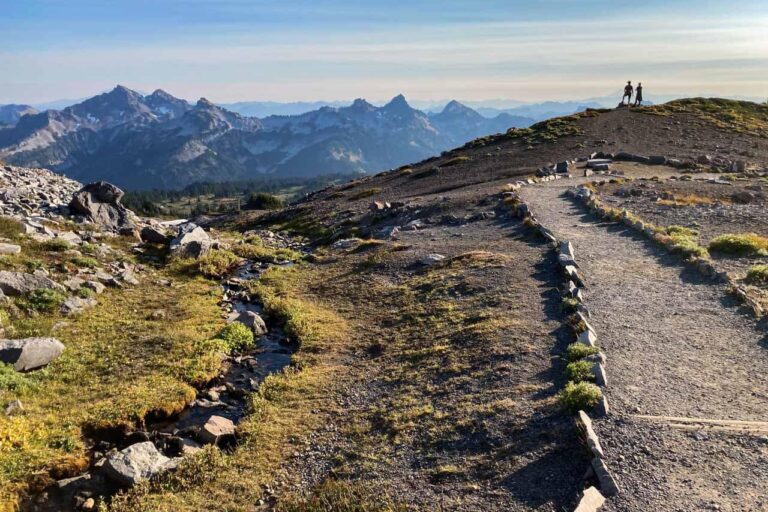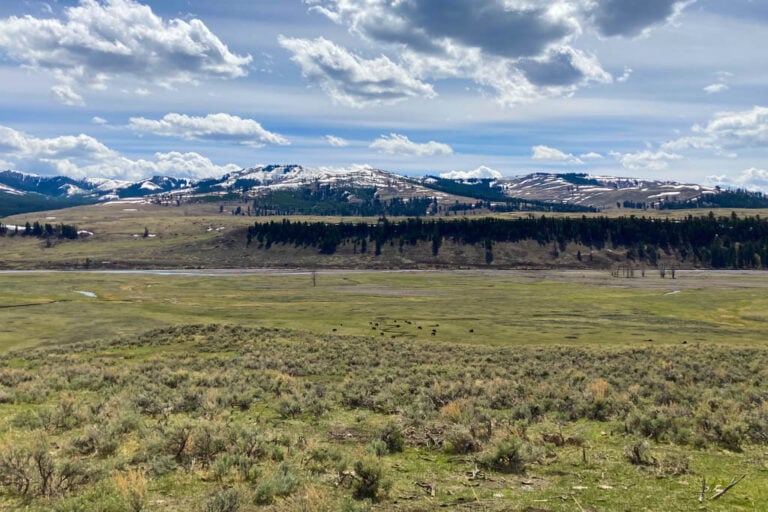Best Spring Wildflower Hikes in the Columbia River Gorge
One of the most visited places in the entire Pacific Northwest, the Columbia River Gorge is famous for many things.
Arguably its best-known features are the innumerable waterfalls that cascade, tumble and fall from the Gorge’s sheer basalt cliffs. While these waterfalls are enjoyable all year, there’s a more seasonal natural attraction in the Gorge, too.
I am, of course, talking about the amazing Columbia River Gorge wildflowers that cover the hills, slopes and plateaus in spring.
Come late-May, thousands of people flock to the eastern Columbia River Gorge to hike among a breathtaking abundance of yellow-colored balsamroot, as well as red Indian paintbrush and purple lupines.
There are over 800 species of flowers in the Columbia Gorge, but it’s mainly the yellow balsamroot and purple lupine that attract the crowds.
On the hikes featured below, you’ll be part of an almost unimaginably colorful landscape. Hiking the Columbia River Gorge in spring is easily one of the Pacific Northwest’s greatest seasonal highlights.
Columbia River Gorge: From Waterfalls to Wildflowers
This post about the best Columbia River Gorge wildflower hikes contains affiliate links. You can read more about our Terms of Use / Disclosure here.
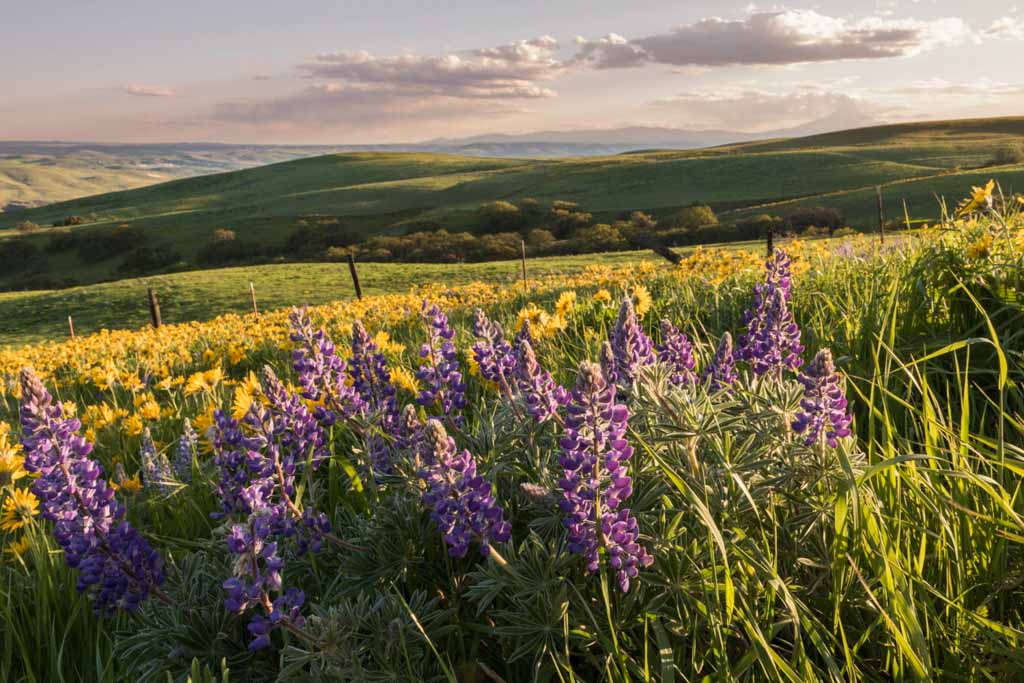
Carved out by the mighty Columbia River, the largest river in the American West, the Gorge is over 80 miles in length and up to 4,000 feet deep. It cuts straight through the Cascade Range, from the inland Columbia Plateau to Astoria on the Pacific Ocean coast.
The Columbia River Gorge consists of two distinct areas. The western Columbia River Gorge is the closest part to Portland and receives the lion’s share of annual precipitation.
As a result, this area is home to countless waterfalls, such as famous Multnomah Falls, Wahkeena Falls and Wahclella Falls. This section runs from Troutdale, just east of Portland, to Hood River.
When you’re looking for the best Columbia River Gorge wildflowers hikes, however, you’ll find those in the eastern part of the Gorge.
Extending eastward from Hood River to The Dalles and beyond, this area is in the Cascade Range’s rain shadows and gets very little rainfall.
This arid region is characterized by treeless hills, wide plains, plateaus, canyons and ranches. It’s on those hills that the famed Columbia River Gorge wildflowers bloom in late-spring.
Best Wildflower Hikes in the Columbia River Gorge (Oregon Side)
The Columbia River forms most of the border between Oregon and Washington. Both sides boast a wealth of wildflowers in spring.
The Oregon side is arguably the most accessible side, home to towns like Hood River and The Dalles and a straight drive east from Portland. Below, I’ve listed my personal favorite wildflower hikes in the Columbia River Gorge in Oregon.
Mosier Plateau Trail

The Mosier Plateau Trail opened up to the public as recently as 2013, the result of a collaboration between the town of Mosier and the Friends of the Columbia Gorge Land Trust.
Since then, it’s quickly become one of the most popular wildflower hikes in the Columbia River Gorge, Oregon.
The trail starts just east of the small Mosier town center, following Mosier Creek across Pocket Park. It then climbs steadily to the top of the plateau, where a floral spectacle awaits.
The flowers atop the Mosier Plateau are sensational in April and May, well worth the 1-hour hike up.
In addition to the wildflowers, you can also enjoy a wonderful view of the Coyote Wall and Labyrinth, situated across the Columbia River in Washington.
- Distance: 3.5 miles (out and back)
- Duration: 2 hours
- Difficulty: Moderate
- Trailhead: Roadside parking just east of downtown Mosier
- Best time: April and May
Memaloose Hills Trail
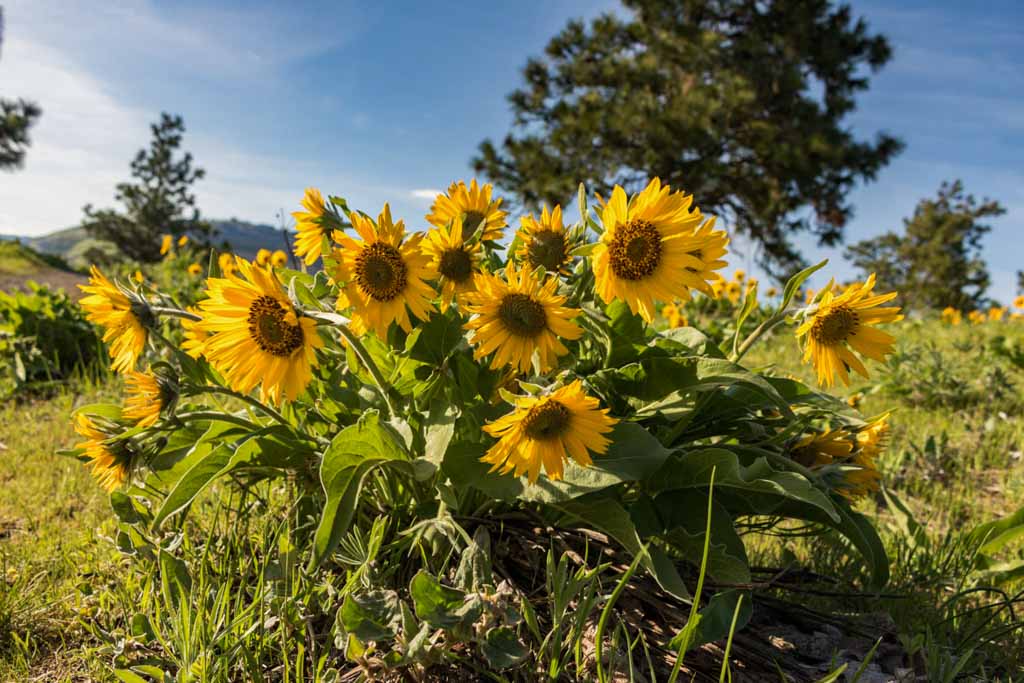
The Memaloose Hills Trail is an unofficial informal trail accessible from either I-84 or the Historic Columbia River Highway. From Memaloose State Park, a trail leads up to the meadows above the roads, which are covered in wildflowers in April and May.
The trail eventually splits up and runs to two separate hilltops: Chatfield Hill and Marsh Hill. Both offer stunning views of the wildflowers, Columbia River and/or the nearest volcanoes, Mt. Hood and Mount Adams.
- Distance: 5.2 miles (out and back)
- Duration: 2-3 hours
- Difficulty: Moderate
- Trailhead: Memaloose Rest Area off I-84
- Best time: April and May
Note: In recent years, social media have made the Memaloose Hills Trail a super-popular Columbia River Gorge wildflower hike, but it’s worth noting and knowing that the parking lots weren’t designed to accommodate dozens of cars per day. If you want to hike Memaloose Hills, it’s best to go early in the morning on a weekday. If there’s no parking available, consider doing one of the other Columbia Gorge wildflower trails in this post.
Rowena Plateau Loop
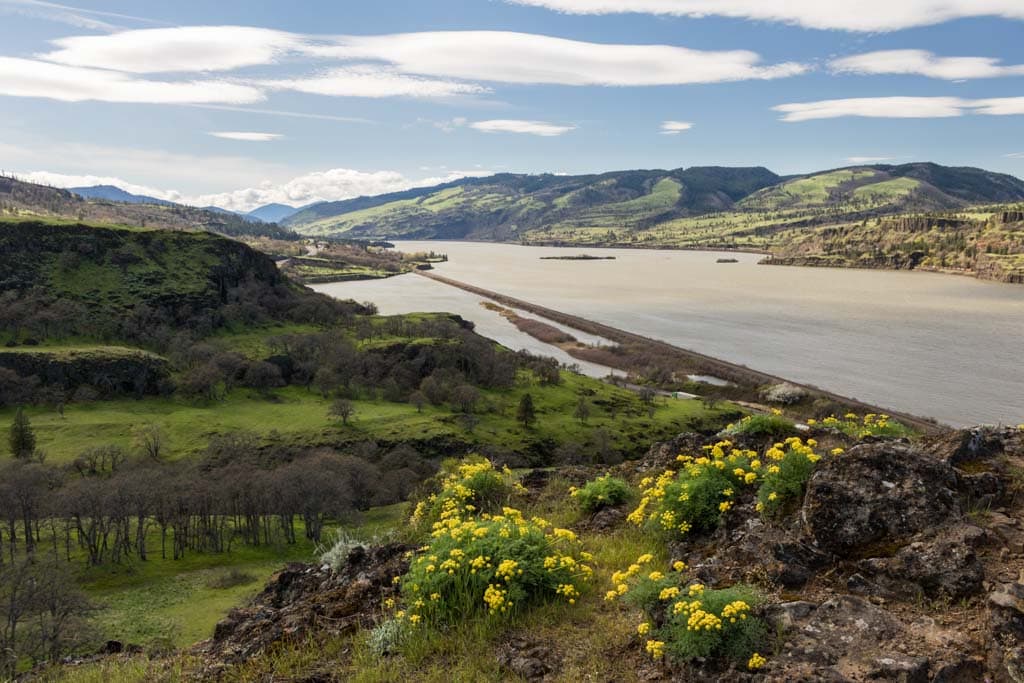
An easy stroll around a wonderful plateau in the eastern Columbia River Gorge comes with gorgeous wildflowers and awesome panoramic views.
The Rowena Plateau Loop is located at Rowena Crest, famous for a series of Historic Columbia River Highway hairpin bends, a popular photo location in the Gorge.
The trail is basically flat and suitable for all skill levels, although it’s not wheelchair accessible. It forms a long and narrow loop around the plateau, which hosts a rich palette of flower colors in spring.
Again, it’s the balsamroot that steals the show, but you’ll find numerous other flower species here, too. At the far end of the loop, there’s an amazing view of the Columbia River Gorge. You can also occasionally catch a glimpse of Mt. Hood.
- Distance: 2 miles (loop)
- Duration: 1 hour
- Difficulty: Easy
- Trailhead: Rowena Crest on the Historic Columbia River Highway
- Best time: April and May
Best Wildflower Hikes in the Columbia River Gorge (Washington Side)
The Washington side of the Columbia River Gorge has an equal abundance of spring wildflowers. This area of ranches, barren hills and riverside cliffs is prime flower habitat.
Numerous trails run through these colorful meadows, crossing hillsides and often offering spectacular views of the Columbia River. This is where you’ll find some of the most famous and best Columbia River Gorge wildflower hikes.
Columbia Hills Historical State Park / Dalles Mountain Ranch
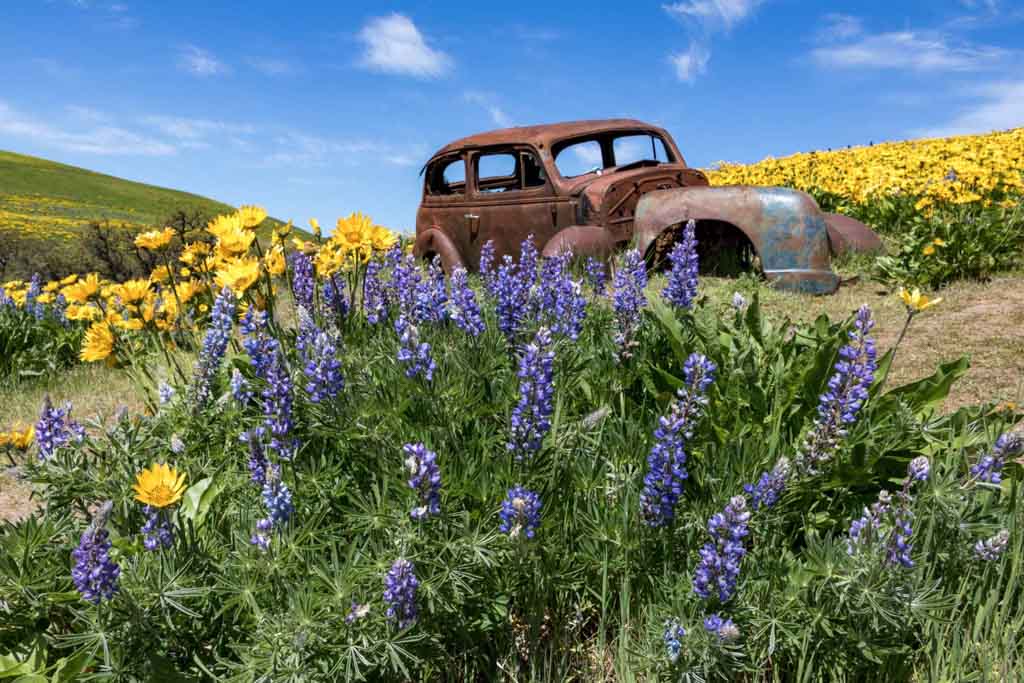
My personal favorite place to enjoy and hike among the amazing spring flowers of the Columbia River Gorge is Columbia Hills Historical State Park.
This stunning state park is part of the Ice Age Floods National Geological Trail, which is National Park Service unit that extends all across the Pacific Northwest.
The park is home to a nice little campground, Native American petroglyphs, sites associated with the Lewis & Clark Expedition, and several geological landmarks such as striking Horsethief Butte.
A number of trails near the campground offer close-up views of the beautiful cliffs and plateaus, which feature a variety of wildflowers in spring.
Arguably the most famous part of the Columbia Hills Historical State Park, however, is the Dalles Mountain Ranch.
Home to abandoned farm buildings, an iconic car wrecks and many miles of trails, this area offers some of the best spring hiking in the Columbia River Gorge.
In addition to the flowers, there’s also a spectacular view of Mt. Hood in the distance.
- Distance: 5-7 miles (loops)
- Duration: 2-4 hours
- Difficulty: Easy
- Trailhead: Dalles Mountain Road, off WA-14 near Smithville
- Best time: April and May
Coyote Wall Trail

The Coyote Wall Trail is one of a handful of popular hikes on the Washington side of the Columbia River Gorge.
In mid-spring, usually from April to late-May, this area display a true kaleidoscope of wildflower colors. From yellow balsamroot to purple lupines, it’s an amazing place to hike around in.
There’s a network of trails near Coyote Wall, a huge columnar basalt formation that’s recognizable from miles away. The Coyote Wall Trail is the main one, running along the edge of this massive rock wall. From the trailhead, you can get there via either the Little Moab Trail or Little Maui Trail.
The views are absolutely sensational here. Quite literally everywhere on this wildflower hike, you can enjoy a panoramic view of the Columbia River Gorge. The higher you hike, the better the vista gets.
On a clear spring day, there’s a great view of the snow-covered summit of Mt. Hood in the distance, too, similar to other Columbia River Gorge wildflower hikes in Washington.
Note: The Coyote Wall area is notorious for its abundance of ticks and snakes. When I hiked the Coyote Wall Trail in mid-May, I saw no fewer than four snakes, including one juvenile rattlesnake. Watch where you step and keep pets close and on a leash (which is required most of the year anyway).
- Distance: 6.8 miles (out and back)
- Duration: 3-4 hours
- Difficulty: Moderate
- Trailhead: Coyote Wall Trailhead off WA-14, just east of the town of Bingen
- Best time: April and May
Dog Mountain Trail
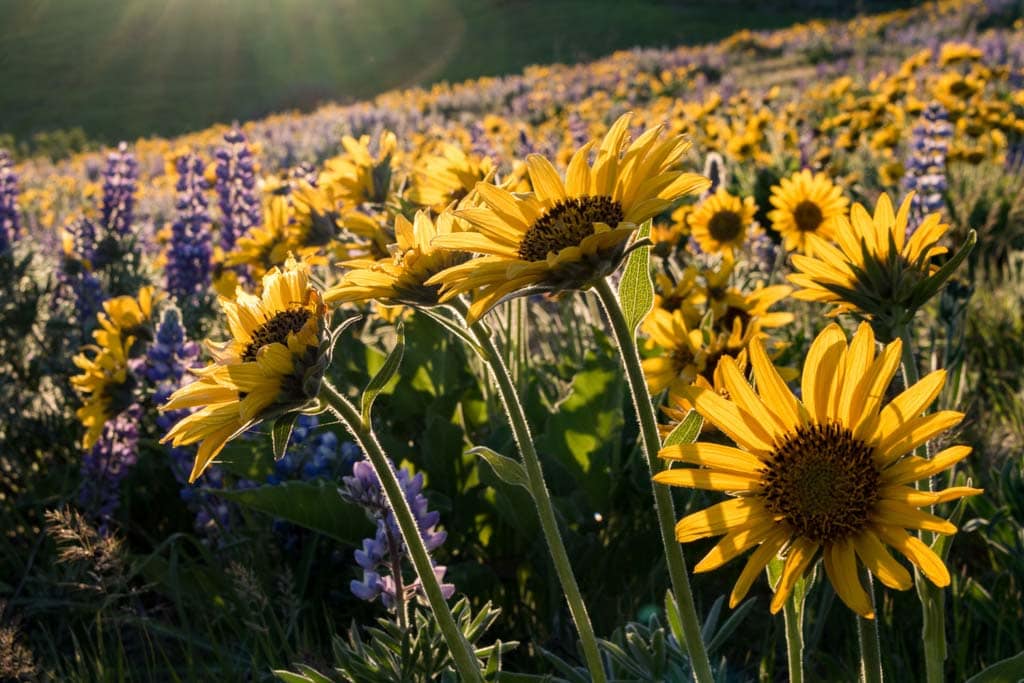
An almost legendary hike in the Pacific Northwest, Dog Mountain is the most popular spring hike in the Columbia River Gorge. It’s also one of the most difficult trails in the entire Gorge. Although it’s only about 6.8 miles long, this epic hike does involve a nearly 3,000-foot climb.
It is absolutely worth the effort, though, as you’ll hike through a sheer abundance of balsamroot while being able to enjoy views of the Gorge almost the entire time.
Remember that Dog Mountain is extremely busy in late-May and early-June. The parking lot is often full, so come on a weekday or very early in the morning to find a spot.
This strenuous hike is one of the greatest day hikes near Portland, certainly among the best, if not the single best, wildflower hikes in the Columbia River Gorge. You’ll certainly earn that craft beer (or two, or three) afterward.
- Distance: 6.8 miles (loop)
- Duration: 4-5 hours
- Difficulty: Strenuous
- Trailhead: Dog Mountain Trail Parking Lot on WA-14, between Home Valley and Cook
- Best time: May and June
More Columbia River Gorge Wildflower Hikes in Washington State
- Catherine Creek
- Lyle Cherry Orchard
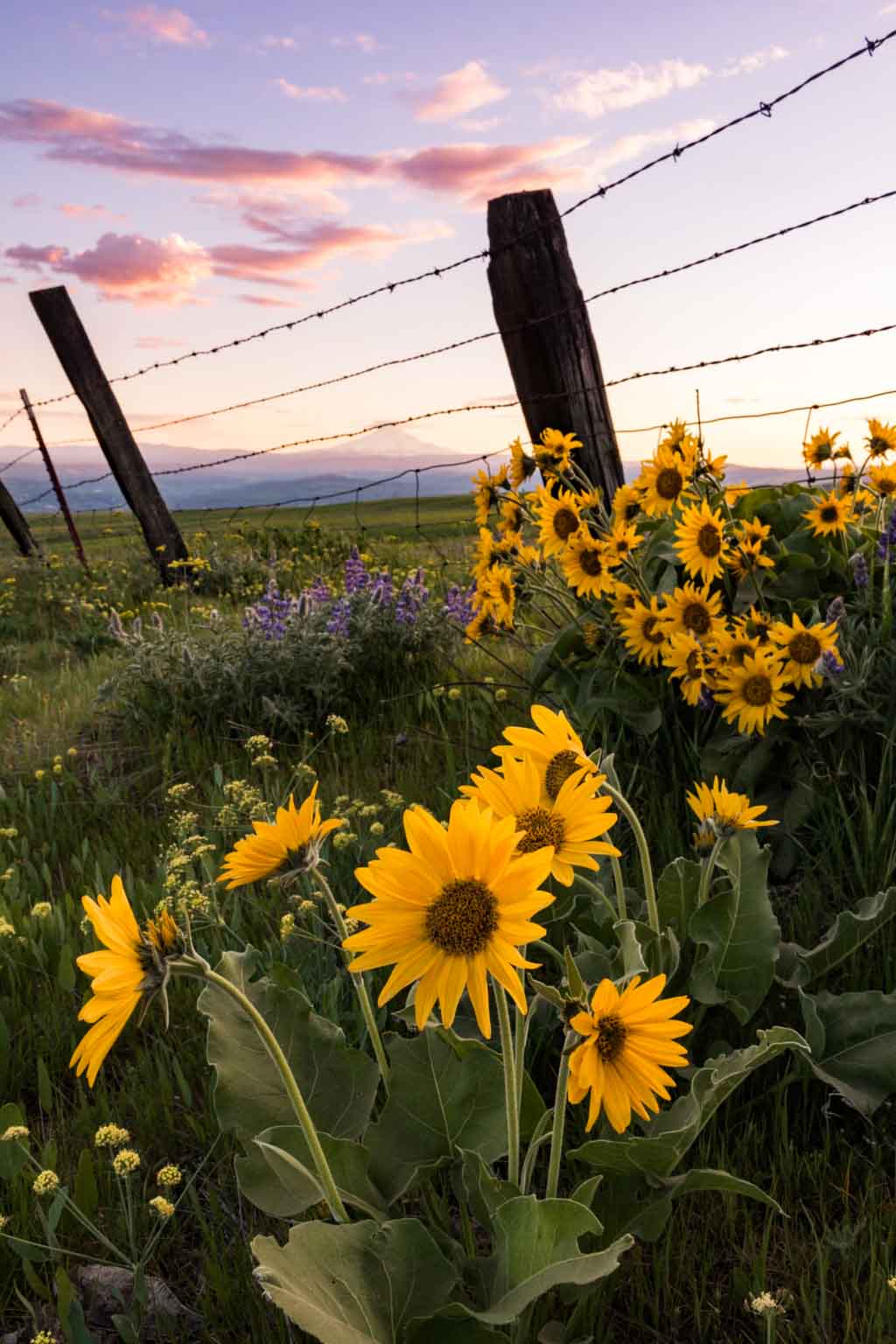
Rattlesnake Safety!
You might not want to hear it, but you definitely should know it. The arid landscapes of the eastern Columbia River Gorge teem with rattlesnakes.
The craggy cliffs, rocky plateaus and rolling meadows are ideal rattlesnake habitat and encounters are not unusual. I’m not saying this to scare you, just to inform you.
It’s possible to meet a snake on all the trails in the Columbia River Gorge with wildflowers mentioned in this post. You can learn more about rattlesnake safety while hiking here.
Additionally, it’s also worth noting that these wildflower meadows are known to be home to ticks and poison oak, too. For all these reasons, I recommend wearing hiking pants on your Columbia Gorge spring flower hikes.
Accommodation Near These Columbia Gorge Wildflower Hikes
Most of these spring wildflower trails in the Columbia River Gorge are between Hood River and The Dalles. They’re either on the scenic Historic Columbia River Highway (Route 30) in Oregon or along, or just off of, WA-14 on the Washington side.
Lodging
If you’d like to do several of these spectacular hikes—a few days in mid-week is best—you could stay in Hood River or The Dalles. Both towns are excellent bases for spring hiking in the Gorge.
Camping
Alternatively, if you like camping, there’s no better campground in the area than the one in Columbia Hills Historical State Park. We spent three nights there during one of our spring trips and it’s amazing.
It offers boating on Horsethief Lake, hiking and rock climbing at Horsethief Butte, and easy access to the gorgeous Dalles Mountain Ranch, which is part of the park.
Additionally, it’s just a quick drive across the river to The Dalles and its restaurants, wine bars and craft breweries. The Historic Columbia River Highway in Oregon is also just 20 minutes away. Again, it’s a fantastic base camp. I can’t recommend it enough!
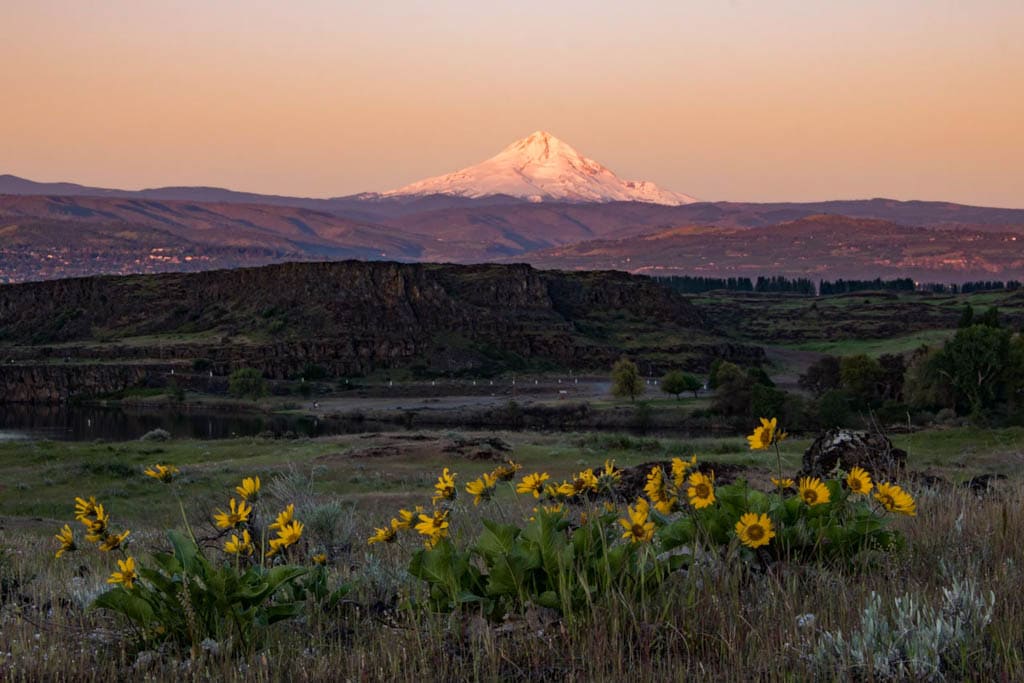
Protect Columbia Gorge Wildflowers, Leave No Trace
Since the wildflowers of the Columbia River Gorge are a seasonal event, this brings out huge numbers of visitors in a short period of time. This massive concentration of hikers can have devastating effects on these fragile natural resources, if visitors ignore rules and guidelines.
After all, every step off the trail could mean one step on a vulnerable flower. A thousand careless steps might kill a thousand flowers. The math is easy.
When going on Columbia Gorge wildflowers hikes in spring, please adhere to posted rules, stay on the trails at all times and follow the Leave No Trace Principles.
Help protect and preserve these delicate flowers for hikers who come after you—you’re here to enjoy them, too, so why destroy them in the process? Respect nature, respect your fellow hikers, be nice, be kind.
Other Things to Do in the Columbia River Gorge
Beyond the wildflowers in the Columbia River Gorge, there are a lot of other things to see and do in the area. From Hood River, situated in the heart of the Gorge, you have four options.
- Return to Portland the way you came, through the waterfall-filled western Columbia River Gorge;
- Drive back to Portland on the Washington side of the Gorge; or
- Turn south, meander through the orchard-dotted Hood River Valley and loop back around Mt. Hood via the Mt. Hood Scenic Byway, completing the most popular loop drive from Portland.
More Pacific Northwest Adventures
- Best Things to Do in Crater Lake National Park, Oregon
- Amazing National Park Service Sites Near Portland, Oregon
- 8 Awesome Things to Do in Deschutes National Forest, Oregon
- What to See and Do at the Painted Hills, Oregon
- Top Attractions in Mount Rainier National Park, Washington
- Best Day Hikes in Mount Rainier National Park, Washington
- What to See and Do in Olympic National Park, Washington
- Top Things to Do Around Lake Quinault, Washington
- All National Parks in Washington State
- 12 Top Things to Do in Redwood National and State Parks, California


